Museums and Exhibitions in New York City and Vicinity
| Home | | Museum Guide | | International | | Architecture & Design | | Theater |
GLENN LONEY'S MUSEUM NOTES
CONTENTS, July 10, 2003
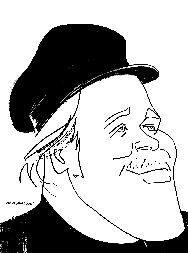
Caricature of Glenn Loney
by Sam Norkin.
[01] Art of First Cities at Met
[02] Hendrick Goltzius, Dutch Master
[03] Manet & American Civil War
[04] GODDESS at the Met
[05] Photography of Charles Scheeler at Met
[06] Roy Lichtenstein on the Met Roof
[07] Whistler, Women, & Fashion at the Frick
[08] Willem Van Tetrode Sculptures
[09] Elie Nadelman at the Whitney
[10] The American Effect: Giuliani Portrait
[11] From Expressionism to the Bauhaus at Neue Galerie
[12] Kazimir Malevich at the Guggenheim
[13] Guggenheim's From Picasso to Pollock
[14] Joan Miró Mural Uncovered
[15] Central Park in Blue
[16] Central Park at Hirschl & Adler
[17] Harlem Lost & Found at City Museum
[18] Art of Mu Xin at Asia Society
[19] World of Buddhism Surveyed
[20] A Taste of CHOCOLATE at the American Museum
[21] Blue Whale Returns to Hall of Ocean Life
[22] At BMA. Egypt Reborn
[23] Pulp Art in Brooklyn
[24] Art Market Notes from Galerie St. Etienne
[25] Hard-hat Tour of MoMA "Reconfiguration"
[26] Soft-hat Tour of Gowanus Canal
[27] Muni Art Awards at City Hall
[28] Dahesh Museum News
[29] Buyers' Options at Armory Shows
You can use your browser's "find" function to skip to articles on any of these topics instead of scrolling down. Click the "FIND" button or drop down the "EDIT" menu and choose "FIND."
For editorial and commercial uses of the Glenn Loney INFOTOGRAPHY/ArtsArchive of international photo-images, contact THE EVERETT COLLECTION, 104 West 27th Street, NYC 10010. Phone: 212-255-8610/FAX: 212-255-8612.
Copyright © 2003 Glenn Loney.
For a selection of Glenn Loney's previous columns, click here.
On View at the Metropolitan Museum—
Art of the First Cities:
The Third Millennium B. C.
From the Mediterranean to the Indus—
[Closing August 17, 2003]
This impressive exhibition was planned long before 9/11—not to mention the more recent Weapons-of-Mass-Destruction Saber-Rattling. So arriving in New York at this time, this handsome show proves especially prescient and fascinating. In the wake of the devastating looting of the treasures of Baghdad's National Museum, it is also of immediate interest. In fact, at the press-preview, experts were able to provide more detailed information on some of the priceless objects that had been stolen and on the extent of the ruinous vandalism of files and records. TV-addicts may not soon forget the reruns of "Defense" Secretary Donald Rumsfeld's dismissive response to questions why the Museum had not been protected against looters: I didn't know there were that many vases in the whole country. This comment spurred one OP-ED writer to note: "The Tigris flows through Baghdad. The Hubris flows through Washington."
Fortunately, some priceless objects had already been stored for safe-keeping. And even some shattered pots can be painstakingly restored. The documentation of such objects, however, has been almost totally trashed by vandals. What was very clear was that some major thefts must have been planned for markets or collectors unknown. These were not random lootings by ordinary Iraquis, suddenly inflamed with the Freedom & Democracy they had been promised by their Liberators in Washington, DC.
Setting aside Megalithic civilization—about which very little is known—the
earliest cities which are now very well documented—and excavated—developed
in the Fertile Crescent, between the Tigris & Euphrates Rivers. The art &
artifacts from Uruk & Ur and other ancient cities now on view at the Met are
both breathtaking and beautiful in their concept and workmanship.
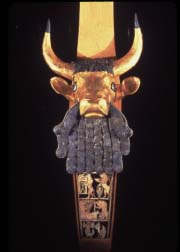 |
Golden Bull's Head on Lyre. Photo: Metropolitan Museum of Art. |
But this handsomely mounted exhibition is not only about early urban cultures of Mesopotamia. Works on display come from the Aegean & Eastern Mediterranean, across Central Asia to the Gulf of the Indus.
On loan from 50 museums in more than 12 nations, there are some 400 precious objects on show. They include sculptures, jewelry, vessels, weapons, cylinder seals & tablets. The artworks are arranged thematically, within a chronology. The intricate mosaic inlays of the Standard of Ur is on loan from the
British Museum. The Rearing Goat comes from the University of Pennsylvania Museum. A Bull's Head is on loan from the Bahrain National Museum.
Although some of the astonishingly artistic objects on view were new to Met regulars, at least two amazing art-objects had been shown fairly recently. One is the magnificent Bull-Headed Lyre, also from the University of Pennsylvania Museum. The other is the impressive golden headdress of a long dead queen from the Fertile Crescent.
There is of course a splendid catalogue, published by the Met and distributed by Yale University Press. It costs $75 in hardcover and $50 in paperback, but hard-bound books of this bulk last much longer. On the Met's website, there is much more information about this important exhibition. Check it out: www.metmuseum.org
Hendrick Goltzius, Dutch Master: 1558-1617—
[Closing September 7, 2003] It has taken a very long time for Hendrick Goltzius to have his First Major Retrospective Exhibition. Considering that he was born in the mid-Sixteenth Century, it could be said this show is long, long overdue. Especially so, as he was regarded during his lifetime as one of Europe's most gifted and versatile artists. And not only in his native Netherlands. His Mannerist talents certainly dazzled fellow-artists in Italy. But his misfortune was to have crested just as Holland was entering its so-called Golden Age. He was subsequently—and almost permanently—overshadowed by the great Dutch painters now known to fame and to the General Public.Goltzius' achievements as an artist-draftsman, engraver, and painter are all the more impressive as his right hand was severely burned in a childhood accident. This deformity he even depicted in a notable drawing. This did not prevent him from creating drawings and engravings of the greatest power and
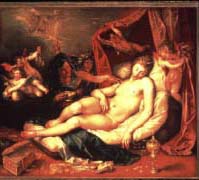 |
DANAE & HER GOLDEN SHOWER--Jupiter rains coins on lazy lady, as envisioned by Hendrick Goltzius. Photo: Metropolitan Museum of Art. |
also of intriguing subtlety.
There are 69 drawings on the Met show, notably his seven-by-five-foot vision of Venus, Ceres, and Bacchus. But even his tiny portraits—no larger than a postage-stamp—are of exquisite invention and workmanship. Goltzius was obviously inspired by the musculature of heroic male bodies, some in extreme poses. Among these, the Farnese Hercules statue was impressively interpreted by his pen. Goltzius preferred mythological subjects to real people, but his portraits of personalities and scenes from the life heralded the rise of Dutch Realism.
Although Goltzius took up painting later in life, his achievements were even more impressive than his major drawings—and certainly more colorful. In this show, 13 of these canvases are on view. His vision of Danaë—in her famous Golden Shower of gold coins, a gift from the lecherous Father of the Gods, Jupiter—is amazing. Not only for its luxurious depiction of the naked lady and the lascivious ogling of her aged nurse, but also for its remarkable palette of colors.
Manet and the American Civil War:
The Battle of the USS Kearsarge & CSS Alabama—
[Closing August 17, 2003] As for 19th century French painters
in America, it was Degas who visited New Orleans. Not Manet. Nor was Édouard
Manet "embedded" on a Union warship during the Civil War. How then could Manet
have painted the sea-battle of the USS Kearsarge and the Confederate sloop-of-war
Alabama? 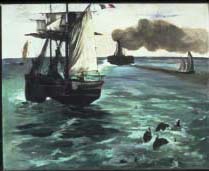 |
US CIVIL WAR OFF FRENCH COAST--Edouard Manet paints the warships. Photo: Metropolitan Museum of Art. |
Obviously, an painter does not have to be present at a current-event to create an "artist's impression" of the scene. And he certainly didn't have to have been present to paint a Manger Scene of the Birth of Christ. Although Manet did not witness the Kearsarge's victory over the Alabama, it was fairly close at hand. Certainly not in the harbor of New Orleans. The battle was fought in international waters near Cherbourg, and the Kearsarge was later anchored offshore at Boulogne-sur-Mer, where Manet was able to visit it and sketch this now famous ship.
Manet's powerful vision of the actual battle is the centerpiece of the current Met show, and it's on loan from the Philadelphia Museum of Art. His painting of the Kearsarge belongs to the Met. There are also five Boulogne seascapes by Manet, as well as works by Manet contemporaries who were influenced by these works: Courbet, Whistler, and Monet. There are also photographs, logs, and other documentation to recreate the sense of this important battle.
What is most impressive, however, is Manet's perspective of the battle, in regard to the turbulent seas and the horizon-line. It lends a powerful sense of immediacy: You Are There!
GODDESS—
[Closing August 3, 2003] You cannot go wrong in fashion if you hew to the classical line. Chitons and Himatia can conceal a lot of bulk on a "full-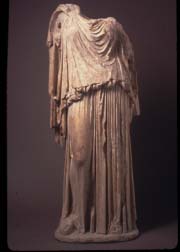 |
HEADLESS GODDESS OF PEACE--Classic model for modern Fashionistas. Photo: Metropolitan Museum of Art. |
The current Costume Institute show at the Met demonstrates the powerful influence of the garbs & gowns of Ancient Greece on fashion over the Millennia. Little actual clothing fabric has survived, but the examples in stone and on painted vases have inspired artists, seamstresses, and fashion-designers to this day.
This elegant and striking new exhibition was an excellent thematic choice, as the Spring Costume Institute show is the focus of the Met's fund-raising "Party of the Year." Although the show itself is confined to three cramped spaces at the bottom of some grand stairs in the Met's basement, the party itself expands outward on the ground-floor, northward into the Temple of Dendur and southward into the classical atrium. Gucci's Tom Ford, as well as Nicole Kidman and Anna Wintour, were Chairpersons. Gucci sponsored the show, with help from Condé Nast.
The actual exhibition—divided into five parts—does not offer examples of classical copying over the centuries. Instead, it begins in the late 18th Century, with the Directoire and the rise of Napoleon I, and onward to Napoleon III and Empire styles in France. But most of the handsome fashions on display are the work of famed 20th century designers: Balenciaga, Schiaparelli, Lucile, Valentino, and Pierre Cardin, Charles James, Gilbert Adrian, Paul Poiret, Madame Grès, Madeleine Vionnet, Yves Saint Laurent, and all the rest of the newer famous-names. This show is a visual treat, but it is also a showcase for the Big Names in Women's Fashions Today.
The Photography of Charles Scheeler—
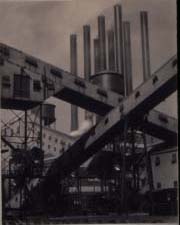 |
CRISS-CROSSED CONVEYORS--Charles Scheeler's famous photo of Ford's River Rouge auto-factory. Photo: Metropolitan Museum of Art. |
One of Scheeler's most famous photographs is the image of the Criss-Crossed Conveyors at Ford's River Rouge automobile plant. But his even more powerful Blast Furnace Interior and images from his Boulder Dam and TVA series are also on view. The latter were commissioned by Fortune magazine, under the rubric of Power. Scheeler's crossed conveyors make an interesting contrast with his images of Chartres Cathedral, made only two years later. He made some abstract nude photos of his wife—which may have inspired Irving Penn's later images in the same vein—but this was fortunately his only venture into abstracting flesh. His lens was more suited to Industrial and WPA imagery.
Plus Photos by Scheeler's Contemporaries—
As an interesting pendant to the Met's Scheeler show, these photos indicate influences and variations. Scheeler's friend Morton Schaumberg also found in Bucks County—and Doylestown/New Hope—some fascinating architectural details. Other noted photographers on view: Margaret Bourke-White, Edward Steichen, Alfred Stieglitz, Berenice Abbott, Walker Evans, André Kertész, Paul Strand, and Edward Weston. Not to forget O. Rotch, who also photographed the Ford River Rouge plant.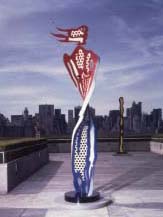 |
BRUSH-STROKE NUDE--Roy Lichtenstein's sculpture against Manhattan skyline on Met Museum roof. Photo: Metropolitan Museum of Art. |
Roy Lichtenstein on the Roof—
[Closing August 17, 2003] Viewed against the East Side, Central Park, and Park South skylines, Roy Lichtenstein's distinctive colored metal sculptures make quite a mark on the Met Museum's roof. The most literal of these is the perspective-challenging House III, set on a patch of lawn. Galatea and Brushstroke Nude offer an interesting take on the female form. Endless Drip is a stylish abstraction on a painterly theme.
On View at the Frick Collection—
Whistler, Women, & Fashion—
[Closing July 13, 2003] Can the Frick be seeking to emulate the Met Museum with a costume-show to attract the fashion-conscious crowd? Certainly the emphasis in this interesting and attractive new exhibition is on fashions in female attire, rather than on pure painting and portraiture. In the elegant Oval Room of the Frick, eight full-length female portraits by James McNeill Whistler are vivid testimony to his sense of style and color—even though some of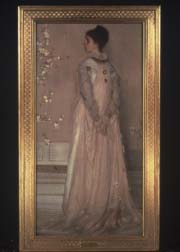 |
WHISTLER AT THE FRICK--Symphony in Flesh Colour and Pink, or Mrs. Francis Leyland. Photo: ©The Frick Collection/2003. |
One of the loveliest of the portraits is Symphony in White: The Little White Girl. More elegant is Symphony in Flesh Colour and Pink: Portrait of Mrs. Frances Leyland. Charming is Harmony in Grey and Green: Miss Cicely Alexander. Most striking is certainly Arrangement in Black: Lady Meux.
Although it would have been enough to honor Whistler's centenary with the portraits alone, the Frick has made this show an in-depth examination of both Whistler's interest in women's attire and the fashions of his time. His own sketches of women in various stations of life, in different times and places, are sharply observed. Patterns could be cut from some of these drawings. There are also costume-plates from leading ladies' fashion-magazines of the day. In the downstairs exhibition-rooms, some handsome gowns are on display. Mrs. Andrew Carnegie's Liberty of London tea-gown could have been painted by Whistler. A Lord & Taylor dinner-dress has a fashionable bustle-effect, with modified train.
Whistler was not only a fashionable painter of fashionable portraits of fashionable society ladies, but he was also an ardent admirer of handsome women. So this show is not only about painting and fashion, but also about Whistler as a man and bon vivant. And, in a way, about the women themselves. The exhibition is accompanied by a handsome catalogue, and two excellent lectures were offered by experts involved in the show: Margaret F. MacDonald—Designing Women: Whistler's Portraits and Aileen Ribiero—A dream of fair women: Whistler and the Art of Dress.
Willem Van Tetrode:
Bronze Sculptures of the Renaissance—
[Closing September 17, 2003] In conjunction with the Met Museum's
Hendrick Goltzius exhibition, the Frick is now showing some Goltzius prints
as a
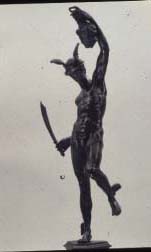 |
MERCURY WITH HEAD OF ARGUS--Willem
Van Tetrode sculpture in Frick Garden Court.
|
The Farnese Hercules inspired both Van Tedrode and Goltzius, but the latter Dutch artist was only briefly in Italy. Van Tetrode spend almost half his career there, winning the admiration of major Italian artists. Hercules and other mythic subjects encouraged Van Tetrode to extremes in molding male musculature, often in contorted poses with bulging muscle-masses. But his three-dimensional visions of the God Mercury are symphonies in light, elegant, frozen movement.
After his long and amazingly developmental stay in Italy, Van Tetrode returned to his native Delft with a new-found sense of the classic. This was to inform Dutch artists who came after him, as well as Goltzius in his own time.
Considering the Frick Collection's primary mission of showing Henry Clay Frick's masterpieces in his handsome Fifth Avenue mansion's noble rooms, it is amazing that this famed museum is also able to mount simultaneous shows of the caliber of the current Whistler and Van Tetrode. The latter artist's works have been splendidly displayed in cases in the verdant central Garden Court, an ideal venue for smaller sculptures.
On View at the Whitney Museum—
ELIE NADELMAN: Sculptor of Modern Life—
[Closing July 20, 2003] Regulars at the New York City Opera have by now grown accustomed to the towering presence of huge white marble females at either end of the New York State Theatre's upper lobby. It has been said that inside these fat ladies are thin women dying to get out. They look like overweight Valkyries, but actually they are enlargements of much smaller sculptures created by Elie Nadelman, who envisioned these ladies as female circus acrobats.Nadelman's most familiar and sleekly stylized sculptures are on a much smaller scale. His charmingly reductive, almost cartoonish, style—a hallmark of the Art Deco period—is certainly distinctive. The current Whitney retrospective fills in the gaps in his career, for his early work in Paris is not so well known in America. Nor is his late work, his rougher sculptural models, made at a time when fame had deserted him and he had lost patrons and public. These plaster-casts & papier-mâché models may be among his very best works.
Perhaps having such early and resounding success—and having Helena Rubinstein buy a handsome collection of Nadelman's classic portrait heads of strikingly generic women for her beauty-salons—marked him as more fashionable than serious. The 1929 Stock-Market Crash proved also disastrous to his fortunes and career.
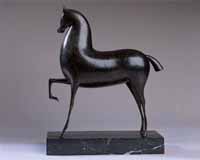 |
"Horse," by Elie Nadelman. Photo: Whitney Museum. |
Were it not for the sleekness and almost comic vision of some of Nadelman's Jazz-Age sculptures, they could be mistaken for a form of American Folk-Art. Indeed, his image of the Woman at the Piano is almost an icon. As is Circus Girl with Hoop. But some of his figures, such as his 1914 Horse, have an Art Deco smartness about them which is almost classic.
This is a totally delightful show and may do much to restore Nadelman's reputation as an artist and a social commentator.
The American Effect—
[Closing October 12, 2003] Thanks to a full-page full-color reproduction of Zhou Tiehai's portrait of Ex-Mayor Rudolph Giuliani on the front-page of the New York Daily News, art-loving New Yorkers will certainly flock to the Whitney's new American Effect show. Hizzoner is shown in a Chairman Mao-style visionary posture, whose effect is only slightly diminished by two big elephant turds on a ledge in front of him.This is an obvious reference to the Brooklyn Museum of Art's Sensation flap, in which an outraged Giuliani sought to censor the show and curtail city funds. The object of his displeasure was Chris Ofili's glittering portrait of the Virgin Mary. The large painting was mounted on elephant-dung footings, which was bad enough for the City Hall's then-resident Roman Catholic Morals-Monitor. Worse, however, was Ofili's use of another huge ball of dung as
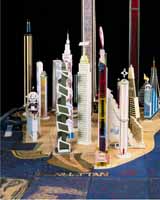 |
Kingelez's "New Manhattan City," part of "The American Effect" at the Whitney. Photo: Patrick Gries. |
the Blessed Virgin's breast. Ofili argued that this use of Natural Materials was a symbol of reverence, as in his tribe's part of Africa, elephant dung is a very important commodity. They heat their food with it, among other things. Mayor Giuliani, on the other hand, was deeply offended and wanted to protect others from this gratuitous insult to Church and State. This seemed more important to Manhattan Manners & Morals than his own abandonment of Family Values.
Zhou Tiehai lives in Shanghai, so Americans who are up to no good or who are making public fools of themselves should be on their guard. Thanks to the Internet, news now travels all too fast. And Shanghai is now a very trendy, high-rise metropolis. As are most of the cities represented by non-American artists in the Whitney's surprisingly amusing and virtuosic new show. Although there are some traces of Documenta and the Whitney Biennials, most of the creations on display are very inventive, some downright impressive. If you were ready to give up on the Whitney, do not do so! This show is a Summer Must, especially as a valuable way to See Ourselves As Others See Us. American Folkways and 9/11 are major sources of comic and sardonic inspiration in this show.
In the forecourt of the Whitney, do not miss Sarah Sze's new installation, a fantastical Urban Garden.
On View at the Neue Galerie—
From Expressionism to the Bauhaus—
[Closing September 15, 2003] This selective overview is sub-titled Highlights from the Museum of Modern Art. Part of the reason for this must certainly be MoMA's current closure at its West 53rd Street site. Although crowds have trekked out to MoMA QNS to see Matisse/Picasso and now the masterpieces of Max Beckmann, other closer venues are needed to show examples of MoMA's extensive modern collections. And the Neue Galerie is ideal for such purposes, dedicated as it is to German and Austrian Jugendstil and Modernism. As an elegant & palatial Fifth Avenue mansion, the building itself is anything but Bauhaus or Expressionistic, but it has been wonderfully adapted and decorated for its new uses.The Galerie's Max Beckmanns are now on view out in Queens, so there is reciprocity involved. Among the painters included on East 86th & Fifth Avenue are George Grosz, Ludwig Kirchner, Paul Klee, Otto Dix, Lyonel Feininger, Hannah Höch, Franz Marc, Emil Nolde, Oskar Schlemmer, and Karl Schmidt-Rottluff. Some objects are also on display: creations of Thonet, Marianne Brandt, Marcel Breuer, and William Wagenfeld. Peter Behrens is represented by a lithograph of his Metallfadenlampe, not by the real thing: the Ding an sich…
On View at the Guggenheim Museum—
Kazimir Malevich: Suprematism—
[Closing September 7, 2003] The stunning forms and colors of Malevich's early works, emerging from experiments in Cubism, promised much for a revolution in art in Russia, just as the Bolsheviks were launching a political and social revolution. A world-shaking revolution, in which Malevich and his fellow-artists were in the vanguard of change. Some 120 Malevich drawings, paintings, and objects are currently on view at the Guggenheim, tracing his development of Suprematism, an abstract art of pure form and color, with nothing identifiably Russian about it. These are visually very powerful, but there is more to their power than what is merely seen. Some early works such as White Square on White or his Black Cross may seem elemental, but they become almost hypnotic when studied closely. Brooklyn's Ad Reinhart's white-on-white canvases owed something to Malevich.Unfortunately, with Stalin's rejection of the abstract in art, in favor of Socialist Realism, Malevich's modernity was doomed. His efforts to suggest a kind of cubist abstraction of reality in a picture of Peasant Women has special power, but it also suggests an attempt to move back from dangerous developments. At last, he retreated into an evocation of Renaissance modes.
FROM PICASSO TO POLLOCK: Classics of Modern Art—
[Closing September 28, 2003] After a number of unusual special exhibitions at the Guggenheim—which have caused some traditionalist art-critics such as Hilton Kramer to complain, if not excoriate—it is a distinct pleasure to see so many of the Guggenheim's Permanent Collection treasures back on view. Among the 130 masterworks by 48 modern artists, many of the canvases—and some of the sculptures—are as iconographic as the finest of MoMA's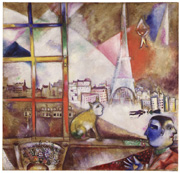 |
"Paris Through the Window," by Marc Chagall. Photo courtesy of the Solomon R. Guggenheim Foundation. |
The installation follows a Modern Art chronology, beginning with Cubism and the School of Paris. Picasso and Braque pictures are of course on the walls, as are fine examples of works by Robert & Sonia Delaunay, Fernand Léger, and Juan Gris. Among so many wonderful—and famous—paintings, my favorite is a small but powerfully composed, almost Art Deco, vertical vision by Gris, Houses of Paris.
Also on view: Beckmann, Brancusi, De Kooning, Calder, Dubuffet, Gabo, Kupka, Kline, Schiele, Mondrian, Popova, Severino, Picabia, Modigliani, Ernst, Klee, and Rothko. Plus outstanding examples of Marc Chagall's shetl scenes, including the Green Violinist—Fiddler on the Rotunda!
And what would the Guggenheim Collections have been without Hilla von Rebay's infatuation with the designs of Vasily Kandinsky? Ample examples are on view here, but no view of Murnau, where he lived and painted with Gabriele Münter in the "Russ Haus," whose wooden stairway he painted with gay designs.
Joan Miró's Immured Mural Re-revealed—
"If these walls could speak…" Of the Guggenheim Museum's famed Frank Lloyd Wright Rotunda they could certainly speak of the many coats of paint they have received over the years—after epic installations which have imposed upon them or altered them. With the removal of the epical alterations of the recent Matthew Barney Cremaster show, the entire Rotunda Spiral smells & feels of fresh paint.But something long forgotten has also been revealed with the removal of the Cremaster objects d'art. At the first level of the rotunda, a false wall has been removed to disclose Joan Miró's Alicia mural. This handsome ceramic artwork has been hidden for more than a decade, to accommodate special exhibitions of paintings & sculptures.
Commissioned by Harry F. Guggenheim to honor his wife, Alicia Patterson Guggenheim, in the mid-1960s, it was designed by Miró for this space and executed in tiles by his Catalan friend Josep Lloréns Artigas.
On View at the Museum of the City of New York—
Central Park in Blue—
[Closing September 28, 2003] This year is the 150th anniversary of Central Park, as laid out by Frederick Law Olmstead & Calvert Vaux—who later designed parks for Saint Louis, Louisville, San Francisco, and other American cities. They won the 1857 design-competition for the new Central Park—which was previously dotted with squatters' huts and other blots on the undeveloped landscape. The Broadway musical, Up in Central Park, dealt with the actual construction—and boondoggling—involved in creating the park enclave.One of the competition-entrants who did not win nevertheless went on to achieve something very important historically for Central Park. Working as a landscape-gardener in the Park, Augustus Hepp was commissioned to photograph some of its major features, such as the Bethesda Terrace, the Boathouse, and the Mineral Springs Pavilion. The US Secretary of State then presented Hepp's photographs in an album to the Government of France.
As some of the structures and landscaping no longer exist, Hepp's photos are important for the record. But they are also interesting in themselves as photographic compositions. In fact, they are especially intriguing for their shades of blue-toning in the images. This was the result of using the Cyanotype method of photographing on a surface coated with chemicals yielding a Prussian Blue image. Later, such treated paper was also used for printing architects' designs. Not to overlook its uses by flower-lovers, who pressed flowers onto the paper in glass frames and exposed them to the sun.
Celebrating Central Park at Hirschl & Adler—
[Closed July 3, 2003] Although this compact but fascinating show has recently closed, some of the artworks included may still be available for viewing. And a visual record is also preserved at Hirschl & Adler's townhouse at East 70th & Madison. Among the items on display were William Merritt Chase's A Bit of the Terrace, before the Bethesda Fountain, and Augustus Saint-Gaudens' gilded Victory—part of the General Sherman statuary on Grand Army Plaza, at the southeast corner of Central Park.Currently even more relevant, however, is Christo's The Gates Project for Central Park, dated 2000. Christo and his partner, Jeanne-Claude, have been promoting this environment-enhancing vision for a long time now, even before Christo wrapped the Reichstag in Berlin. But successive City Hall regimes have rejected it for various odd reasons. Among them: that it might attract too many people to Central Park. Or that it would invite the "wrong element."
Christo's drawings—the sale of which helps finance such projects, free of public subsidy—show a series tall U-shaped pipe-uprights spaced along the walkways, with glowing golden clothes suspended and waving in the breeze. Nothing gets "wrapped," and no lawns get trampled. The Gates in fact make the walks and landscape-vistas even more attractive. And they won't cost the City or the Taxpayers a cent. Christo and Jeanne-Claude explained this to me in detail just after they finished the Reichstag Project, which I photographed for INFOTOGRAPHY.
Harlem Lost & Found—
[Closing January 4, 2004] Treasures of Historic Harlem, as well as architectural & cultural artifacts, are now installed in an effectively designed exhibition at the Museum of the City of New York. The show takes its name from curator Michael Henry Adams' book, and it opens with color photos of contemporary Harlem and residents who are guarding the testimonies of the past.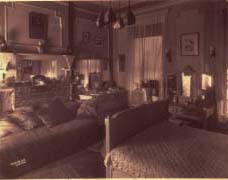 |
MADAME WALKER'S BEDROOM--On view in "Harlem Lost & Found" at Museum of City of New York. Photo: ©Museum of City of New York/2003. |
There are some very old prints and paintings of Harlem long before it was part of the City of New York. Harlem at this time was out in the country. Here were mansions in woodland settings. Also race-tracks. And the country-estate of Alexander Hamilton, Hamilton Grange, as well as the Morris-Jumel Mansion, where Aaron Burr once visited his lady-friend, Madame Stephen Jumel, as imagined by novelist Gore Vidal.
Most of the show, however, is devoted to photos and artifacts of Harlem of a more recent vintage, such as the Audubon Theatre & Ballroom, with its memorable ceramic-tile sculpture over the entrance archway. The first African-American female millionaire, Madame C. J. Walker, is represented not only with photos of her beauty-salon and home, but also with a partial reconstruction of her bedroom.
Architectural artifacts and objects of daily life are largely from the Museum's collections, as are artworks and photos. But Paul Rocheleau has also contributed some vivid color photographs of Harlem today.
Landscape of Memory: The Art of Mu Xin—
[Closing September 7, 2003] Beware of tyrants with heroic slogans! Beware of mottoes like: Make a Thousand Flowers Bloom. During a false lull in Chairman Mao's Cultural Revolution, this encouragement emboldened dissidents and artists to come forward with ideas and images for a New China.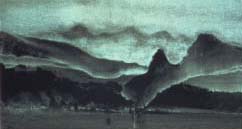 |
CHINESE CULTURAL REVOLUTION PRISON PAINTING--On view at Asia Society in Mu Xin's "Landscape of Memory." Photo: ©Asia Society/2003. |
The amazing Chinese artist/writer Mu Xin managed to survive both prison [1971-72] and house-arrest [1977-78], with both his intellect and artistic vision intact, even enhanced by the experience of forced meditation. Pages of his finely written meditations—on hidden pieces of paper. which he managed to smuggle out of prison—are almost artworks in themselves. But his musings—drawing on both Asian and Western culture and philosophy—are often profound and deeply moving. A suite of 66 of these pages is now on view at the Asia Society, along with English translations of some of the more moving observations Mu Xin made in prison.
There are also over thirty ink-and-gouache drawings he made in prison when guards were not watching. These are small smoky misty landscapes, most horizontal rather than the traditional verticals of hanging-scrolls. They seem a fusion of Western and Chinese styles and images: all quite haunting. Mu Xin is a really distinctive modern Chinese artist, and this show is a revelation.
The World of Buddhism—
 |
NEPALESE BODHISATTVA IMAGE--Enlightened Being from John D. Rockefeller III Collection at Asia Society. Photo: ©Asia Society/2003. |
This handsomely mounted exhibition demonstrates how conventional ideas about Buddha and his divine entourage took form in various cultures over time. Some of the differences in portrayals of the Buddha in stone, wood, or on paper are astonishing, but all are certainly powerful visually. Their emotional and spiritual impact can hardly be imagined by non-Buddhists.
On View at the American Museum of Natural History—
A Taste of CHOCOLATE—
[Closing September 7, 2003] This is not only a tasteful but also a very tasty exhibition. In fact, the gift-shop is so overstocked with Godiva Chocolates that, on exiting, one has the sensation of just having passed through an extended Godiva video-commercial. Nonetheless, the show is effectively designed to highlight what is essential and to make the details more interesting. In effect, it is also bi-lingual, not only for the benefit of Latino schoolchildren, but also because so much of Chocolate's History has been centered in Spanish-speaking countries.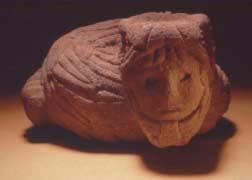 |
AZTEC GOD & CHOCOLATE--Quetzalcoatl, the Feathered Serpent, on view at American Museum of Natural History. Photo: ©American Museum of Natural History/2003. |
In keeping with the American Museum's dedication to Natural History, viewer-attention is focused on the geographical areas of cacao-tree cultivation, on planting, growing, and harvesting the beans, on shipping, milling, marketing, and on the nature and uses of the bean itself. But the social & cultural developments involving chocolate as a drink, flavoring, and confection in the Western World are also documented. Once the pods are off the trees and the beans are roasted and milled, the manufacturing and packaging aspects take over, so brand-names such as Nestlé and Baker's Chocolate are on view in this show as well.
Here are some Fascinating Chocolate Facts from the American Museum:
·Seed-pods grow not on cacoa-tree branches but on the trunk.
·No relation to coconut palm or coca plant, source of cocaine.
·Cacoa seeds are not sweet: they taste bitter.
·Each pod is about the size of a pineapple, holding 30 to 50 seeds, enough to make two dark chocolate bars.
·Cacao flowers are pollinated by midges, whose tiny wings beat as much as 2,000 times per second.
·Cacao trees are now threatened by the witch's broom fungus.
·Africans do not consume much chocolate, though a great deal of it is grown there.
·Americans spent $13 billion on chocolate in 1998: On average, each American eats 12 pounds of chocolate per year.
THE BLUE WHALE IS BACK!
Milstein Family Hall of Ocean Life Reopens—
[Permanent Installation] One of the American Museum of Natural History's "Signature" exhibition-objects has long been its immense Blue Whale. But this mammoth mammal had grown a bit tatty over the decades, so repairs & restorations had to be made, requiring this huge finned creature to leave its lair in the air of the Hall of Ocean Life. |
THE BLUE WHALE IS BACK--Poised for a dive in Milstein Family Hall of Ocean Life. Photo: ©American Museum of Natural History/2003. |
If Lenin's corpse and Chairman Mao's mummy need periodic beauty-treatments, why not the Blue Whale as well? Actually, taxidermy was not the problem, as the Blue Whale is not a preserved specimen, but a fiberglass & polyurethane model of a female blue whale found in 1925. This is The Largest Model of the Largest Creature that has ever lived on Earth. So say the Museum's experts.
Now the Blue Whale's back, high in the air, level with the mezzanine and swooping downward toward the main-floor courtyard. This space is flanked with 14 restored dioramas of deep-sea scenes and seals, polar bears, and walruses on land.
On the mezzanine, there are eight new Ocean Ecosystem displays, with high-definition video-screens showing the amazing diversity of marine habitats.
It's not clear [to me, at least] whether the hall's full name refers to the entire Milstein Family as donor/sponsors. Or if it is intended to suggest a Hall for Families to enjoy themselves and learn about Squids, Blue Whales, and Portuguese Men-of-War? Whichever: It is good that it is now open and has been so well rethought and re-designed! In fact, at a recent Family Evening for the arts-press, kids had a wonderful time, especially with the great video-screens teeming with ocean life.
Fish & Chips, anyone?
On View at the Brooklyn Museum of Art—
EGYPT REBORN: Art for Eternity—
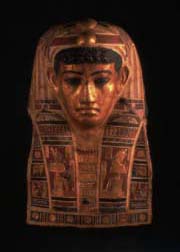 |
G0LDEN FACE FOR EGYPTIAN MUMMY--On view in new "Egypt Reborn" galleries at Brooklyn Museum. Photo: ©Brooklyn Museum of Art/2003. |
Most of the artifacts on display in the new galleries are splendid indeed, but placing major objects in free-standing glass-cases does seem rather retro, even though it does permit mummy-cases to be seen both back & front. Wall colors, graphics, and wall-texts have been modernized, with a view to inviting museum visitors to spend more time on individual displays and study them in depth.
In general, the sculptures, reliefs, hieroglyphic texts, cult-objects, stele, jewelry, and tomb-finds are organized chronologically. But the central pivot of the galleries is thematic: Permanence & Change. This installation does not work as well as intended. The carpentered constructions created for the displays tend to clutter the large space, isolating one section from another. They make what should be a grand open arena into a potential traffic-jam, waiting for warm bodies to look at the embalmed ones.
Pulp Art: Vamps, Villains, & Victors—
[Closing August 31, 2003] Some high-minded art-critics have dismissed this colorful & amusing show as unworthy of a Museum which insists on having Of Art attached to its title. But then this is the same museum that sponsored the very controversial show, Sensation, which so inflamed ex-Mayor Rudolph Giuliani, with its portrait of the Virgin Mary with a breast made of elephant dung.No such offenses to Organized Religion are now on view in Pulp Art. But damsels are very much in distress: Rape and worse constantly
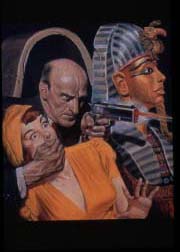 |
PULP ART & MUMMY TERROR--Rafael de Soto painting for cover of "New Detective" magazine, at BMA. Photo: ©Brooklyn Museum of Art/2003. |
threaten—notably from sinister non-Caucasian villains. Collector Robert Lesser has been able to find both the often outrageous magazine-covers and the original cover-art created for them. Most of the canvases or boards are impressive in the vibrancy of their colors, the power of their compositions, and the evocative potential of their image-stereotypes.
Commissioned from a specialist group of illustrators—who also get some spotlighting in this show—the visuals were come-ons for such magazines as Famous Fantastic Mysteries, The Shadow, Doc Savage, Terror Tales, Spicy Mystery, & Thrilling Wonder Stories. Despite the lurid illustrations and titles, some of the stories were by Ray Bradbury, Zane Grey, and Louis L'Amour. Because of the cheap paper used for printing, the mags were called "pulp." Street & Smith was a major publisher of such titles.
Covers for The Shadow are some of the most impressive in this show. Among the illustrators represented are: H. L. Parkhurst, George Rozen, Rafael de Soto, Virgil Finlay, and J. Allen St. John. The catalogue for the show is almost as lurid—and fascinating—as the art on display.
Robert Lesser also collects toy-robots and similar space-toys. A selection of these was shown at the BMA two years ago.
On View at Galerie St. Etienne—
Recent Acquisitions on View,
Plus Observations on the Art Market—
[Closing September 12, 2003]
If you are an admirer—or even better, a collector—of the works of Käthe Kollwitz, Egon Schiele, Gustav Klimt, Sue Coe, or Wiener Werkstätte artists such as Kolo Moser, Dagobert Peche, & Josef Hoffmann, the current show at Galerie St. Etienne should be of interest. Also on view are the so-called Artists of Gugging, and self-taught, naive, or brut artists such as Henry Darger and Grandma Moses. But even if these artists and their work are well known to you already, you might stop by the gallery on West 57th Street to get a copy of the current show's brief catalogue. It also has some disturbing Thoughts about the Current Art Market. This excellent essay is unsigned, but it surely represents the informed judgments of the gallery-founder's heir, Jane Kallir. With the Economy in stagnation, major corporations indicted for malfeasance, and the Future very uncertain, middle and lower-level artworks are not much in demand. But at the upper levels, Masterpieces seem to be what are wanted. Unfortunately, most of the authentic ones are in major museums or private collections. An emerging problem is the effort of some dealers to promote average artworks to Master Status. And the recent scandals at the major auction-houses have hardly increased collector-confidence. Let the Buyer Beware, or Caveat Emptor, as Caesar used to say.
NEWS & NOTES—
Hard-Hat Tour of MoMA "Reconfiguration"—
MoMA's Director Glenn Lowry and colleagues recently took New York art & architecture journalists & critics on a tour of the half-completed expansion of the Museum of Modern Art's 53rd/54th Street home. Meanwhile, crowds are surging to its temporary home in Queens: MoMA QNS, in the old Swingline Stapler Factory. The lure of the recent Matisse/Picasso show had people lined up for four blocks on a late Monday afternoon. In Queens! |
HISTORIC MoMA MUSEUM RECONFIGURED--Architect's sketch of changes on West 53rd Street. Photo: MoMA. |
Lowry and the new MoMA's architect, Yoshio Taniguchi—via video from Tokyo—strongly made the point that this is not a new MoMA , but rather an expansion of the older complex of structures, incorporating on the 53rd streetscape the signature Edward Durrell Stone & Philip Johnson façades. Even the popular Modern Sculpture Garden will be preserved. Not as it was shortly before the museum's recent closure, but as it existed before the glass-atrium & escalators were installed!
Taniguchi's ingenious, even self-effacing, design almost doubles the exhibition and office-space on site. Obviously, he is not interested in Making a Statement with his contribution. Not only will the space available be dramatically increased, but some of it will provide immense open areas previously not possible.
This may prove a mixed blessing. When the last enlargement/makeover of MoMA was carried out—including the income-producing apartment-tower—the creation of new long galleries suggested that at last there would be sufficient room to show Masterpieces of the Modern side-by-side.
But, alas, some wily Modern Artists saw their opportunity and created abstract horizontal panoramas which completely pre-empted the new spaces. The bigger Modern Art Galleries become, the larger are the paintings, sculptures, and installations created for them. Do museums & galleries pay these artists by the yard?
The new/old MoMA will open in late 2004 or early 2005. Construction is already ahead of schedule. But at the Morgan Library, extensive new construction work—to link the three major existing buildings—has just begun, so the Morgan won't be re-opened until 2006 at the earliest. Even now, its recently opened glass-atrium is being dismantled.
Soft-Hat Tour of Brooklyn Waterway:
Red Dive's Production of Peripheral City:
Rediscovering the Gowanus Canal—
For many years, your reporter used to drive to work at Brooklyn College in Flatbush from Brooklyn Heights. One section of the elevated highway passed over the Gowanus Canal. Its waters looked dark & fetid, hemmed in on either side by cement-plants, dump-sites, factories, and crashed-car lots. Obviously, a lot of toxic effluent was being routinely dumped into this turgid stream, emptying out into New York Harbor. But I never had the least interest in exploring the Canal or its environs, As it is at its most accessible from Brooklyn's beautiful Carroll Gardens, I should have done so long ago. Recently, I had the opportunity not only to tour a section of the Canal, but also to enjoy an Alternative Theatre On-Site Production by Red Dive.
Our tour-craft was piloted by Capt. Bill Sheehan, of Hackensack Riverkeeper. Over in New Jersey, some enlightened Environmentalists have become interested in reclaiming abused or neglected waterways for public enjoyment and recreation. Such projects in San Antonio and Houston, for instance, have made formerly ugly—even repellent—city rivers into major tourist-attractions.
Currently, there is a lot of interest in developing waterside areas in New York City for public purposes. Anyone who has been to DUMBO—Directly Under Manhattan Bridge Overpass—knows how breathtaking it is to stand opposite Manhattan, squarely between the diverging spans of the Brooklyn and Manhattan Bridges, with all the downtown skyline on parade—especially at night.
Some of the industrial architecture already in place on the Gowanus Canal is as impressive as some of Charles Scheeler's industrial photos now on view at the Met Museum. Certainly these should be saved—Urban Sculptures, if you will!
These structures offer GREAT PHOTO-OPPORTUNITIES! Even the overpass of the Brooklyn-Queens Expressway offers inviting possibilities.
But other areas—such as dead-truck parking-lots, gravel-heaps, and rubbish-dumps—need to be terminated or relocated far away.
Given the lovely gardens and Victorian mansions of Carroll Gardens, a reclaimed and reconceived Gowanus Canal could make this neglected section of Brooklyn a real tourist destination. As well as enhancing the small-town lifestyles of the locals!
Red Dive highlighted selected sites on the canal-tour with antic performers—some with unusual props—making these sound & sight-bites notable. An charming young African-American drill-team on the canal's President Street swing-bridge brought the water-safari to a triumphant conclusion. Unfortunately, the show was only on view the last two weekends of May.
Watch for their next Environmental Adventure! Red Dive has won awards for its site-specific performance-art & installations. Memorable was its Haunted House Tour of the Lower East Side Settlement House. For more info on their work, the Gowanus Canal, Captain Bill Sheehan, & other environmental reclamation-projects, call Red Dive at: 1212-615-6797. Publicist Karen Greco can also provide more info: 1212-560-9868.
INCIDENTAL NOTE: It was like old times to stroll down President Street again. I had not been there since 1965! My cousin, the Rev. Theron Zimmerman, had been appointed Pastor of South Congregational Church on President. This beautiful church—now a group of condos—was founded by the famed Reverend Dr. Henry Ward Beecher. His celebrated Brooklyn Heights Plymouth Church of the Pilgrims—where he held an Abolitionist Mock Slave-Auction in the pulpit—had become too small for all the Congregationalists in the very big City of Brooklyn. Beecher, so the story goes, rode out one day in his buggy until he reached an open field and planted his buggy-whip: "Here will stand South Congregational!" Theron later was called to the Moravian Church in Doylestown, PA.]
The 110th Tenth Meeting of the Municipal Art Society—
Echoes of the Gowanus Canal—if not the smells—reached all the way into Manhattan and even deeper into the historic Council Chamber of City Hall. One of the Municipal Art Society's Annual Awards was given to David Sharps of The Waterfront Museum, set up on a barge on the Brooklyn waterfront in Red Hook. From remarks by His Honor Mayor Michael Bloomberg, Council Speaker Gifford Miller, and Muni Art President Kent Barwick, it's clear that cleaning up and developing the city's varied waterfronts for public use and enjoyment is becoming a priority.Other Awards winners were the Tribeca Film Festival, SummerStage in Central Park, and the Alliance for the Arts, chaired by Randy Bourscheidt. Alexander Garvin was accorded a special tribute, presented by architect & Muni Art member Hugh Hardy. He won the Society's Brendan Gill Award for his historic preservation of the New Victory Theatre on 42nd Street.
One of the Municipal Art Society's important current initiatives is the Adopt-a-Mural program. The great oval mural in the City Council chamber is badly in need of cleaning, and the Society is going to see this to completion. Mayor Bloomberg suggested the discoloration of the painting was caused by years of Council Members smoking cigars in the elegant room.
After the Bunker-Mentality of the Guiliani Years—when art & history-loving citizens could not gain access to City Hall to study its handsome chambers, Founding-Father portraits, antique furnishings, and other attractions—this event was something special, with guided tours of all the chambers. Notable is the recently restored Governor's Room—actually a suite of three rooms, with important portraits and George Washington's Writing Table.
What used to be the Board of Estimate's Hearing-Room—where preservationists once gathered to Save Radio City Music Hall, Broadway theatres, and other landmarks from demolition—is now Mayor Bloomberg's open-office computer-pit, where no one gets to hide in a private office or even a cubicle. Not even His Honor!
Concurrently at or near City Hall are some six unusual art-projects, presented by the Public Art Fund under the rubric of METROSPECTIVE. In the City Hall lobby is Do-Ho Suh's classic pedestal, Maquette for Public Figures. Initially, it looks merely like an empty pedestal, but its base is supported by scores of tiny figures. The famed "Little People" who actually pay taxes? Ken Landauer has set up two monster picnic tables—in the basic backyard redwood model—outside the Brooklyn Bridge/City Hall subway station. He calls these objects Picnic Tables. You can sit on them while waiting to enter City Hall for awards-events!
Direct from the Dahesh—
Just Announced: Peter Trippi has been named the new Director of the Dahesh Museum of Art. And the museum will open in the IBM Building, on 3 September, with a new & inaugural exhibition: French Artists in Rome: Ingres to Degas, 1803-1873.The Dahesh Museum recently made an impassioned plea to take over the former Huntington Hartford Gallery of Modern Art on Columbus Circle. Your reporter wrote a letter in support of this request. The gallery's owner—the City of New York—was eager to be rid of it. The building's offices & galleries had been used for functions of what in Europe might have been the Municipal Ministry of Culture. The City made no real effort to maintain the once handsome exterior of the gallery, possibly to make it easier to dispose of. Or demolish…
Although the Dahesh specializes in Academic Salon Painting & Sculpture of the 19th Century, it is certain that it would not have altered the unusual proto-Modernist facade of the Edward Durrell Stone structure. It would have restored the exterior, not remodeled it.
Instead of the Dahesh, however, the new proprietor of the building will be the American Craft Museum, which plans to make some major alterations in the exterior & interiors of the gallery. Although some knowledgeable New Yorkers had come to love the Hartford, there were a number who always hated its exterior. But some of these had already always hated Durrell Stone's designs anyway…
In any case, the Gallery had become part of Manhattan's architectural history & heritage. As such, it should have been spared a make-over. At least it was not awarded to developer Donald Trump, who recently made over the old Gulf & Western Building on the other side of Columbus Circle. When the structure was awarded to the American Craft Museum, Trump insisted he had been promised it by the Giuliani Administration.
The Hartford Gallery will of course remain in the present configuration, for the "footprint" of the structure occupies a very odd-shaped lot on the circumference of Columbus Circle. This outline proved unfortunate for the display of canvases, as the individual exhibition-galleries were too small and too oddly conformed for major works. Fortunately, the Craft Museum displays objects, not paintings.
The Dahesh Museum has in fact been very fortunate in obtaining instead a new premises in the IBM Building at the corner of Madison Avenue & 57th Street. The spacious exhibition-spaces were formerly host to many magnificent shows presented by the IBM Gallery. Before financial difficulties at IBM forced their closure. Compared with the cramped second-floor-through gallery the Dahesh formerly occupied on Fifth Avenue, its new home will be even more central—and vastly more expansive!
In conjunction with the popular huge Post-Modernist Atrium on the IBM's ground-floor, the Dahesh is sure to become a major meeting-place for the midtown lunch-time crowd and the late-afternoon pre-theatre masses. They also will surely be impressed by the grandeur of some of the Dahesh's salon paintings!
Buyers' Options at 7th Regiment Armory—
As your reporter lives only a few blocks away from the historic Seventh Regiment Armory, every new show of Antiques, Art Deco, Paintings, Modernism, Sculpture, or Works on Paper is a welcome treat. As regulars also know, it is always a rewarding experience to study the 19th century fortress-architecture of the Armory and its imposing Victorian interiors, including the magnificent Louis Tiffany chamber.Among the most impressive of the dealer-shows mounted in the Armory are those produced by Sanford L. Smith Associates. Not only are major galleries from around the United States represented, but important dealers from Britain and the Continent as well. Increasingly, however, Wendy's shows are also attracting galleries with unusual and interesting inventories.
But, since 9/11, it is clearly a Buyers' Market. People are obviously being more careful about making investments in artworks, antiques, and fine furniture, silver, glass, ceramics, and graphics. Not only the uncertainties of the [un]forseeable future, but also the rapidly declining economy suggest caution & prudence.
As a result, in some recent shows, there seemed to be fewer booths on display. Not to overlook a diminishment in the crowds of flusher times. Interestingly, however, the quality of arts-merchandise has been improving. And the presentational design of individual booths has clearly also improved, making the wares more attractive in handsome mini-interiors. Wendy's April Armory Antiques Show was especially rewarding in this regard.
That Times Are Hard has been made clear to your reporter, however, by some show-producers who have refused to permit a guest to accompany your unpaid scribe. On several recent occasions, I have even been asked NOT to come to Benefit Previews. The amount of [free] sliced ham & cubed cheese I might have consumed would hardly have made a difference in the money being raised to benefit a charity or a museum.
Speaking of snacking & eating, the 7th Regiment Armory Mess on an upper floor is in fact open to the public. Its decor resembles Mock-Bavarian, a wan contrast to the historic elegances of the ground-floor corridors and chambers. The food itself is nothing to rave about, but it helps to explain why military dining-halls are traditionally called Messes. [Loney]
Copyright © —Glenn Loney 2003